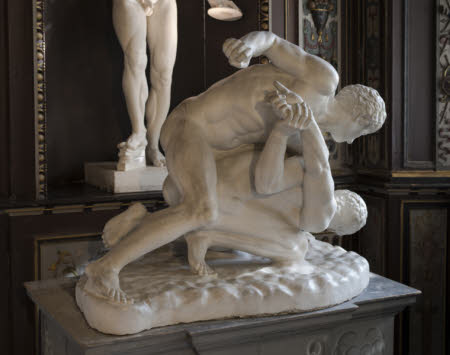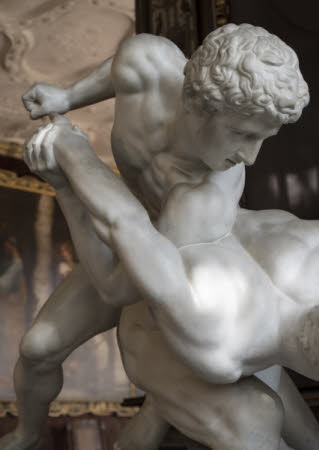The Wrestlers
Category
Art / Sculpture
Date
1770 - 1799
Materials
Plaster, painted
Measurements
950 x 1180 x 740 mm
Place of origin
Italy
Order this imageCollection
Knole, Kent
NT 128706
Summary
Plaster group statue, The Wrestlers, late eighteenth century copy after the ancient Roman marble statue now in the Uffizi Gallery, Florence. The statue depicts two naked male figures engaged in 'pankration', an athletic contest with some similarities to wrestling and boxing, but without as many rules, first introduced to the Greek Olympic Games in 648 BC. The upper wrestler is in the stronger position and is about to overpower his opponent; his left leg is entwined beneath the lower wrestler's left leg and he has grasped the right arm of the lower wrestler in his left hand, his shoulder firmly pressed into his back. His right arm is raised behind him. The muscles of both wrestlers are highly defined, demonstrating their strength and the physical exertion of the contest. The plaster is painted and the statue is displayed on a painted wooden plinth.
Full description
The Roman marble version of the The Wrestlers (c.1st century BC) is thought to be a copy of a now lost ancient Greek bronze original (c. 250 BC). The Roman copy was rediscovered in 1583 and caused a great sensation. The sculpture, along with another group of statues called the Niobids, were purchased by Ferdinando Cardinal de' Medici, where they were added to the gallery of antiquities at the Villa Medici. The statue later became a central work in the Tribuna of the Uffizi in Florence, where it was depicted in Johann Zoffany's famous painting of 1722. The statue was a must see for British Grand Tourists, and as a result many copies in bronze and plaster were made of the statue and placed in country houses in Britain. The Knole plaster was first noted in the 1799 inventory where it was located in the 'Drawing Room next to the Cartoon Gallery'; the sculpture was described as 'Two Boxers in plaister, on a Pedestal (the above Figures large as Life).' The statue was possibly acquired by John Frederick Sackville, 3rd Duke of Dorset (1745-1799), who undertook a lavish Grand Tour in 1769 and bought a large number of works of art in Italy. Anna Moore (July 2018)
Provenance
First recorded in the 1799 inventory of Knole, located in the Cartoon Gallery. Probably acquired by John Frederick Sackville, 3rd Duke of Dorset (1745-1799).
Credit line
National Trust Collections (Knole, The Sackville Collection)
References
Haskell and Penny 1981: Francis Haskell and Nicholas Penny, Taste and the Antique, The Lure of Classical Sculpture 1500 - 1900, New Haven and London, 1981, p. 337-9, no. 94


